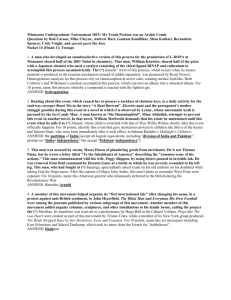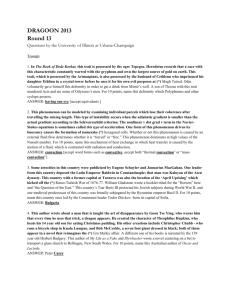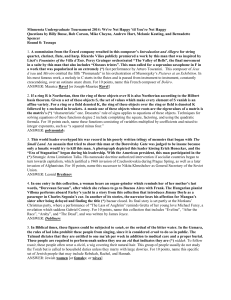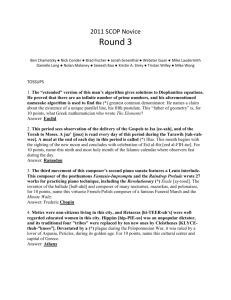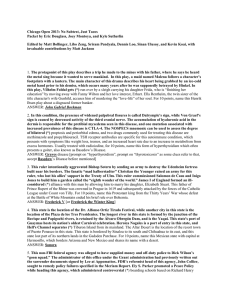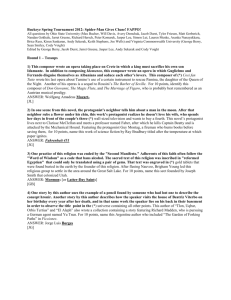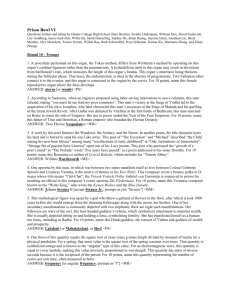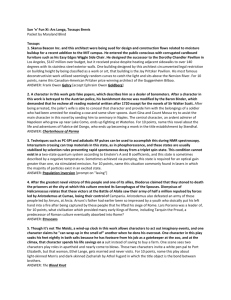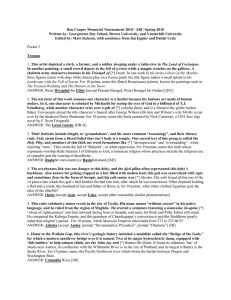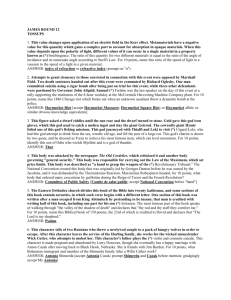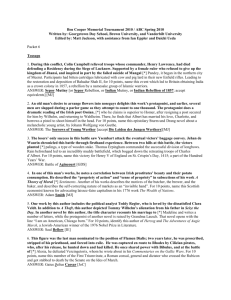Chicago Open 2013--Round 2 - Collegiate Quizbowl Packet
advertisement
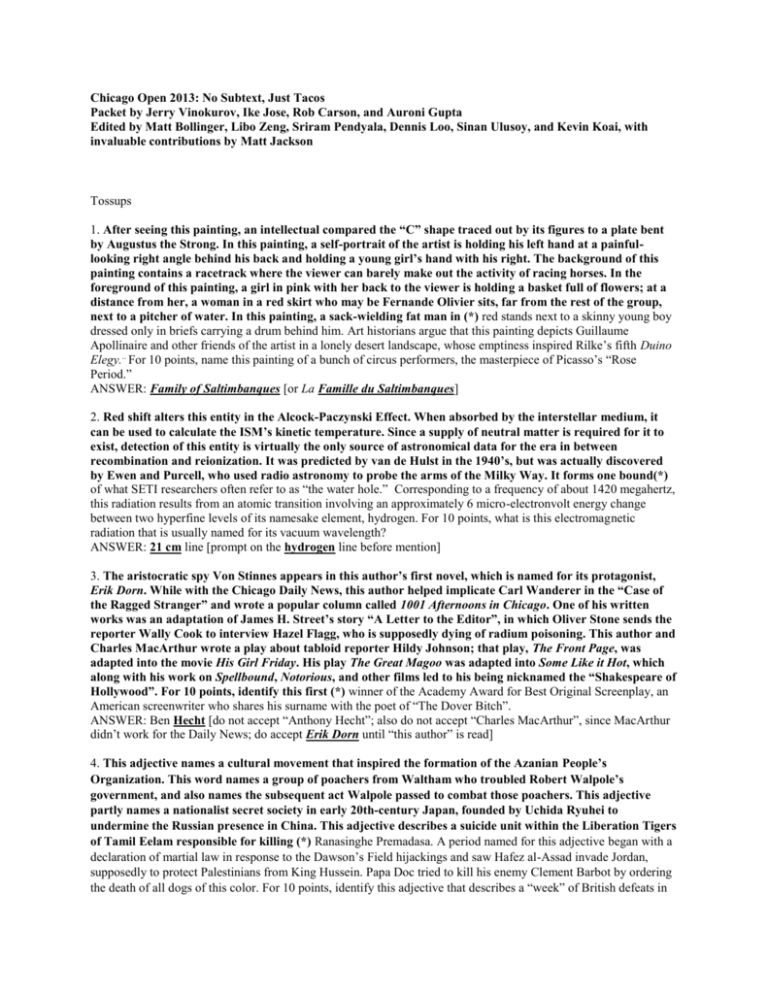
Chicago Open 2013: No Subtext, Just Tacos Packet by Jerry Vinokurov, Ike Jose, Rob Carson, and Auroni Gupta Edited by Matt Bollinger, Libo Zeng, Sriram Pendyala, Dennis Loo, Sinan Ulusoy, and Kevin Koai, with invaluable contributions by Matt Jackson Tossups 1. After seeing this painting, an intellectual compared the “C” shape traced out by its figures to a plate bent by Augustus the Strong. In this painting, a self-portrait of the artist is holding his left hand at a painfullooking right angle behind his back and holding a young girl’s hand with his right. The background of this painting contains a racetrack where the viewer can barely make out the activity of racing horses. In the foreground of this painting, a girl in pink with her back to the viewer is holding a basket full of flowers; at a distance from her, a woman in a red skirt who may be Fernande Olivier sits, far from the rest of the group, next to a pitcher of water. In this painting, a sack-wielding fat man in (*) red stands next to a skinny young boy dressed only in briefs carrying a drum behind him. Art historians argue that this painting depicts Guillaume Apollinaire and other friends of the artist in a lonely desert landscape, whose emptiness inspired Rilke’s fifth Duino Elegy... For 10 points, name this painting of a bunch of circus performers, the masterpiece of Picasso’s “Rose Period.” ANSWER: Family of Saltimbanques [or La Famille du Saltimbanques] 2. Red shift alters this entity in the Alcock-Paczynski Effect. When absorbed by the interstellar medium, it can be used to calculate the ISM’s kinetic temperature. Since a supply of neutral matter is required for it to exist, detection of this entity is virtually the only source of astronomical data for the era in between recombination and reionization. It was predicted by van de Hulst in the 1940’s, but was actually discovered by Ewen and Purcell, who used radio astronomy to probe the arms of the Milky Way. It forms one bound(*) of what SETI researchers often refer to as “the water hole.” Corresponding to a frequency of about 1420 megahertz, this radiation results from an atomic transition involving an approximately 6 micro-electronvolt energy change between two hyperfine levels of its namesake element, hydrogen. For 10 points, what is this electromagnetic radiation that is usually named for its vacuum wavelength? ANSWER: 21 cm line [prompt on the hydrogen line before mention] 3. The aristocratic spy Von Stinnes appears in this author’s first novel, which is named for its protagonist, Erik Dorn. While with the Chicago Daily News, this author helped implicate Carl Wanderer in the “Case of the Ragged Stranger” and wrote a popular column called 1001 Afternoons in Chicago. One of his written works was an adaptation of James H. Street’s story “A Letter to the Editor”, in which Oliver Stone sends the reporter Wally Cook to interview Hazel Flagg, who is supposedly dying of radium poisoning. This author and Charles MacArthur wrote a play about tabloid reporter Hildy Johnson; that play, The Front Page, was adapted into the movie His Girl Friday. His play The Great Magoo was adapted into Some Like it Hot, which along with his work on Spellbound, Notorious, and other films led to his being nicknamed the “Shakespeare of Hollywood”. For 10 points, identify this first (*) winner of the Academy Award for Best Original Screenplay, an American screenwriter who shares his surname with the poet of “The Dover Bitch”. ANSWER: Ben Hecht [do not accept “Anthony Hecht”; also do not accept “Charles MacArthur”, since MacArthur didn’t work for the Daily News; do accept Erik Dorn until “this author” is read] 4. This adjective names a cultural movement that inspired the formation of the Azanian People’s Organization. This word names a group of poachers from Waltham who troubled Robert Walpole’s government, and also names the subsequent act Walpole passed to combat those poachers. This adjective partly names a nationalist secret society in early 20th-century Japan, founded by Uchida Ryuhei to undermine the Russian presence in China. This adjective describes a suicide unit within the Liberation Tigers of Tamil Eelam responsible for killing (*) Ranasinghe Premadasa. A period named for this adjective began with a declaration of martial law in response to the Dawson’s Field hijackings and saw Hafez al-Assad invade Jordan, supposedly to protect Palestinians from King Hussein. Papa Doc tried to kill his enemy Clement Barbot by ordering the death of all dogs of this color. For 10 points, identify this adjective that describes a “week” of British defeats in the Boer War, as well as a “Hole” where British people were held in Calcutta. ANSWER: black [or Black Consciousness Movement; or Black Act; or Black Dragon Society; or Black Tigers; or Black September] 5. At neutral pH, the enzyme myrosinase assists in the plant defense against herbivores by cleaving a glucosinolate like sinigrin and leaving behind these types of compounds in plants of the order Brassicales. Because it induces apoptosis, the phenethyl derivative of this group is studied for its potential in cancer prevention. A lachrymatory effect is produced by the colorless allyl compound with this group, which accounts for the pungent taste of wasabi and horseradish. Another glucosinolate example is sulforaphane, which is obtained from broccoli, brussel sprouts, and cabbages and is a potent anti-cancer compound containing this group. Compounds with this group selectively modify the ends of cysteine, tyrosine, and lysine side chains as well as the alpha amine in the N-terminal end of peptides. That reactivity is taken advantage of in the Edman degradation, which uses the phenyl-substituted group of this kind to sequence amino acids. For 10 points, name this chemical group consisting of R-N-C-S. ANSWER: isothiocyanate [under no circumstances should you prompt on partial answer] 6. This composer wrote a passacaglia movement based on an incessantly repeating D in the bass, which shifts to F at the movement's climax. That passacaglia, adapted from this composer's earlier Passacaglia and Rondo, is the fourth movement of his third symphony. This composer's fifth symphony contains a four-bar theme using only the notes B-flat, F, and C, which he adapted from a Korean folksong. A loud D-major triad occurs on the word “gloria” in an otherwise atonal setting of the Stabat Mater that appears in one of this composer's sacred works, and that work also ends unexpectedly with a tutti E-major triad. His second symphony gets its nickname from its extensive quotation of (*) “Silent Night.” He based one work on visual pitch notation derived from actual electroencephalograms. This composer of a “Christmas” Symphony and Polymorphia also wrote a piece originally titled 8'37”. For 10 points, name this composer who used 52 string instruments to produce massive tone clusters in his Threnody to the Victims of Hiroshima. ANSWER: Krzysztof Eugeniusz Penderecki 7. The sayings of one group of these people were gathered into a collection around 450 C.E. under the name Apophthegma Patrum. In Islamic tradition, these people lived in dwellings called rabitah, and al-Arabi gives an example of one of these people named Abu Yahya al-Sunhaji. Sulpicius Severus wrote a noted biography of one of these people, Martin of Tours, who was instrumental in expanding the numbers of these people in Gaul in the 4th century C.E., while a noted British member of this group wrote a book called (*) Revelations of Divine Love. Basil of Caesarea led one of the few reactions against these people in Eastern Christianity, where they are most prominent, and most early Christian examples of these people were named after tax evaders. Exemplified by such people as Simeon, who to avoid people seeking his prayers spent his time sitting on a pillar, as well as Julian of Norwich and St. Anthony, for 10 points, identify these people sometimes called “anchorites,” who engage in religious contemplation by isolating themselves from the world. ANSWER: eremites or hermits [or anchorites before it is read; prompt on “Christians” before “Islamic”, do not accept “monks” or other wrong answers] 8. This man argued for a topological understanding of geography based on movement cost-maps in a 1999 speech titled “The World is Shriveling as it Shrinks,” and his recent work has been concerned with graphical representations of human migrations using so-called “flow mapping.” One of this man’s most famous contributions was made in a paper which relied on previous work of Borchert and Deskins and the concept of spatial autocorrelation to create a growth model of a midwestern city; that paper was titled “A Computer Movie Simulating Urban Growth in the Detroit Region.” In that paper, this man argued that “everything is related to everything else, but near things are more related than distant things,” a statement sometimes known as his namesake First Law of (*) Geography. For 10 points, identify this pioneering geographer at the University of California, Santa Barbara. ANSWER: Waldo Tobler 9. A military figure in one of these wars died when he became angry during a wrestling bout, causing all of his battle scars to simultaneously open, making him bleed to death. The craziest of these wars involved a oneeyed woman sent back to her side riding a one-eyed horse, with her one-eyed groom and one-eyed dog; the other side in that war had earlier massacred 395 men, women, and children by herding them into a cave and lighting a fire at its entrance. Another of these conflicts was intensified when the Earl of Argyll pretended to offer several men safe passage into exile, only to bring them to the gallows. A major faction involved in these wars was later annihilated by a third party in the (*) Glencoe Massacre. The longest one lasted from 1369 all the way to 1745, when the remnants of these civil conflicts were resolved at the Battle of Culloden Moor. For 10 points, name these conflicts, fought between groups of people like the Macdonalds and Macleods, which ensured a healthy flow of blood in the Scottish Highlands. ANSWER: Highland clan wars [or highland clan feuds; or Highland Wars; prompt on Scottish civil wars] 10. An inscription reading “Truth prevails” is at the base of an Art Nouveau monument in this city, showing a robed national hero upright in the midst of fallen warriors while a woman breastfeeds a child to represent his nation’s rebirth. One of the original gates of this city, named as it is now because it used to store explosives, is the Powder Tower. Josef Gocar designed a Cubist museum in this city named for a statue of a Black Madonna. David (*) Cerny sculpted a bunch of black, stone babies and placed them such that they appear to be climbing up a TV tower in this city. On the outskirts of this city is the Sedlec Ossuary, a chapel with an entire chandelier made of bones. A different tower in this city contains the oldest still-operating astronomical clock. Another iconic building in this city, which resembles a “crushed can of Coke” next to a swollen cylinder on stilts, is occasionally named for Fred Astaire and Ginger Rogers. For 10 points, name this European city where Frank Gehry collaborated with Vlado Munic on a “dancing house.” ANSWER: Prague 11. Jan von Dogiel described the cogwheel appearance of type I cells in this system. One congenital disorder of this system arises from the failure of craniocaudal neuroblasts to migrate during the first trimester. Besides being implicated in Hirschsprung’s disease, this system is also responsible for generation of the Migrating Motility Complex. Some cells in this system provide the input to interstitial cells of Cajal, and the cells of this system are primarily found in (*) Auerbach’s and Meissner’s plexuses. Achalasia is another disorder of this system, whose receptors are located in Peyer’s patches. Sometimes called “second” or “little” brain, drugs targeting this system aim at controlling peristalsis and increasing motility. For 10 points, name this branch of the autonomic nervous system that aids in movement through the GI tract. ANSWER: enteric nervous system [accept intrinsic nervous system, prompt on nervous system, autonomic nervous system, peripheral nervous system or gastrointestinal system] 12. As a military supervisor, this man’s work included the oversight of the Army of the Rhine under Philippe Le Bas, as well as an oversight and commanding role over the Army of the North during the Battle of Fleurus. This man laid out his moral and political vision in a book that was meant to explain the actions of the National Assembly titled L’Esprit de la Revolution et de la constitution de France, and as a member of the Montagnard faction, he gave a speech arguing against the trial of Louis XVI in favor of a straight-up execution. As a member of the Committee for Public Safety, this man engineered the executions of Hebert and Danton, actions which helped give him the moniker (*) “Angel of Terror,” though he himself would be executed only a few months afterwards. For 10 points, identify this French revolutionary, who was executed alongside Georges Couthon and Maximillien Robespierre during the Thermidorean Reaction. ANSWER: Louis Antoine Leon Florelle de Saint-Just 13. An old man promises to reveal the location of this character to another character who styles himself “Father of gods who could do everything in this world,” if that character can retrieve an item from a blacksmith. After becoming a “big bird like an aeroplane,” the narrator of the work in which this character appears flies with his wife to the location where this character is said to reside, only to be told that this character left two years ago for a place to which there is no road, necessitating travel through the (*) bush. In the work in which this character appears, the narrator, remembering the advice of his elders, takes his own and his father’s juju and sets out to find this character, who had died after falling from a tree. For 10 points, identify this figure whom the narrator sets out to retrieve from Deads’ Town in Amos Tutuola’s The Palm-Wine Drinkard. ANSWER: the palm-wine tapster 14. One of this thinker’s essays asks if “Aristotle's use of a low-fat diet to illustrate the practical syllogism suggests that chicken is at the heart of Aristotelian virtue,” and notes the lack of answer to rhetorical questions about “the agency of a subject…presuppos[ing] its own subordination.” This thinker argued against the “magical ideas of contamination” underlying the use of shame or disgust to justify laws in the book Hiding from Humanity, and noted that Plato undermines Socrates’s “ladder” approach to (*) love by making Alcibiades barge into the Symposium. This author’s essay “The Professor of Parody” attacked Judith Butler. She also worked with Amartya Sen on the “capability approach” to global development. For 10 points, name this author of The Fragility of Goodness and Sex and Social Justice, a female law and philosophy professor at the University of Chicago. ANSWER: Martha Nussbaum 15. This speech suggests that “defeats in which nobody loses anything of value” result from filling one’s “workshop” with “anything but the old verities and truths of the heart.” A speech quoting and updating this one, but given by a different orator, opens by noting how Antonio Pigafetta found “tongueless pelicans” and “clawless birds” in Latin America. This speech praises the focus of “young men and women” who toil in the “agony and sweat of the human spirit” to “create something which did not exist before.” It mocks those who think that the presence of a “puny inexhaustible voice, still talking” after the “last dingdong of (*) doom has clanged” suggests that man is immortal, instead saying “I believe that man will not merely endure: he will prevail,” despite the threat of nuclear war. Gabriel Garcia Marquez quoted this speech on the same occasion thirty-two years later, appropriately given that this speech’s author helped inspire the town of Macondo. For 10 points, name this 1949 speech, addressed to young writers, given in Stockholm by the recently recognized author of The Sound and the Fury. ANSWER: William Faulkner’s Nobel acceptance speech [prompt on Faulkner’s speech or partial answers; or William Faulkner’s Banquet Speech; or the acceptance speech for the 1949 Nobel Prize in Literature] 16. James Ledbetter dismissed Douglas Brinkley’s assertion that James Killian was responsible for the deletion of a certain word from this speech. It advocates the necessity of a “prolonged and complex struggle” against a danger of “infinite duration” in order to remain on a “charted course toward permanent peace and human betterment.” Written primarily by future University of Minnesota president Malcolm Moos, it describes how the “solitary inventor...has been overshadowed” and asserts that government contracts have become “a substitute for intellectual curiosity”. This speech advocates avoiding “the impulse to live (*) only for today” in order that democracy does not become “the insolvent phantom of tomorrow” and asserts that, until recently, “American makers of plowshares” could, as needed, make swords as well. For 10 points, identify this speech which warns against the “acquisition of unwarranted influence” by the “military-industrial complex”, delivered on January 17, 1961 by the outgoing President. ANSWER: Dwight David “Ike” Eisenhower’s farewell address [accept logical equivalents for “farewell address” like “final public speech”] 17. This poem’s second section describes a “fair bark” whose "sails light up / the slip of smooth clear blue betwixt two Isles / of purple shadow”. In this poem’s final section, the speaker tells of watching the “black wing” of the “last rook” crossing “the mighty Orb’s dilated glory” and claims that to its addressee, “no sound is dissonant which tells of life”. That final section opens with a “delight [coming] sudden on” the heart of its speaker, who realizes that “Nature ne’er deserts the wise and pure.” Addressed to Charles (*) Lamb, this poem is chronologically the third of its author’s “conversation poems”. It opens with the poet lamenting how his friends “are gone, and here I must remain”, because a burned foot caused him to miss a journey across the Quantocks. For 10 points, identify this poem in which Samuel Taylor Coleridge regrets having to hang out alone under a linden. ANSWER: “This Lime-Tree Bower my Prison” 18. This quantity is now used to explain the anomalous velocity that appears in Karplus and Luttinger’s theory of the anomalous Hall effect. The numbers introduced to study the quantum Hall effect by Thouless et al. were interpreted using the ideas behind this quantity in terms of eigenvalue degeneracies in an one article; that article also identifies this quantity as a holonomy associated with the connection that transports a vector along a curve defined in a region of parameter space defined by a multiparameter family of Hermitian Hamiltonians. In general, this quantity is obtained by a path integral over some closed loop in parameter space for a quantum mechanical system undergoing an (*) adiabatic change. Barry Simon wrote an influential 1983 paper on this quantity. The most famous demonstration of the existence of this quantity are the interference fringes that result when a double-slit experiment is performed with a solenoidal coil which creates a vector potential that in turn induces this quantity. For 10 points, identify this quantity, a phase factor acquired by a particle in such experiments as the Aharonov-Bohm experiment. ANSWER: Berry’s phase [accept geometric phase] 19. Two characters born here were rulers of the Tyrsenoi named Ardeas and Latinus. A character who died in this location asks to be burned in his armor and buried by the sea, with only an oar to mark his gravestone; that character broke his neck after slipping off a ladder in this location. One inhabitant of this place absolved the Argonauts for the death of Absyrtus and turned Picus into a woodpecker. This site of the death of (*) Elpenor was the birthplace of the father of Italus, who sacked an island that he thought was Corcyra and in the process killed his father with the spine of a stingray. In its most famous appearance, this island was visited shortly after Telepylus, the city of the Laestrygonians, and was the place where Hermes gave the herb moly to a certain hero. Eurylochus avoided its most famous inhabitant’s use drugged wine to turn some sailors into swine. For 10 points, Odysseus and his remaining crew spent a year on which island, the home of the sorceress Circe? ANSWER: Aeaea [or Eëa; or Aiaia; anti-prompt on “Circe’s house” or equivalents] 20. One of this author’s essays includes fragments from an detailed manual for an appliance called the “PZ40” and from a questionnaire asking questions like “Would you rather spend your vacation with an eighty year old leper or Demi Moore?”, asserting that the writing of those things is among the title “Remunerative Professions”. Another of his essays compares the Lyndon B. Johnson Presidential Library to Superman’s Fortress of Solitude while describing instances in which “the American imagination demands the real thing and, to attain it, must fabricate the absolute fake”; that essay was originally called (*) “Faith in Fakes”. In the title essay of another of his collections, he described communication difficulties at a hotel causing him to be charged for consuming astronomical amounts of minibar alcohol, which he had actually moved to safely store a certain smoked fish. For 10 points, name this prolific essayist of Travels in Hyperreality and How to Travel with a Salmon, also the author of such novels as Baudolino and The Name of the Rose. ANSWER: Umberto Eco TIEBREAKER The major account of this man’s deeds is paraphrased in the so-called “Short Report” and includes an episode in which a Muslim woman from Hornachos prophesied doom for many explorers, but great wealth for those that survive. In 1544, this man was arrested in Asuncion and brought to Seville in chains, where he was tried and sentenced to exile in present day Oran, Algeria. This man, who often imitated scenes of the Bible out of piety, was regarded as a (*) medicine man when he started curing many Indians through prayer and herbs. An account of this man’s deeds and travels are preserved in his namesake La Relacion, and he was the treasurer of the Narvaez expedition, which included a voyage from Florida to Galveston Island. For 10 points, identify this explorer and conquistador who explored the American South and Mexico during the early 16 century. ANSWER: Álvar Núñez Cabeza de Vaca th Bonuses 1. Its fundamental theorem states that the subgroups of a namesake group have a one to one correspondence to subfields of the namesake field. For 10 points each: [10] Identify this branch of mathematics that establishes a relationship between group theory and field theory, named for a French mathematician. ANSWER: Galois Theory [10] The aforedescribed Galois field is one of these fields that are supersets of a basis field. For example, the field a plus b times the square root of 2 is one of these for the rational number field. ANSWER: field extensions [10] This now-isolationist mathematician extended Galois theory to topoi and other types of categories by introducing a quantity called the fibre functor. He also pioneered the study of topological K-theory and the use of schemes in algebraic geometry. ANSWER: Alexander Grothendieck 2. Alice Aisgill dies in a car accident in this novel, whose protagonist disdains the downtrodden, emotionless people he regularly refers to as “zombies”. For 10 points each: [10] Identify this 1957 novel about the social-climbing accountant Joe Lampton, who outduels Jack Wales for the hand of Susan Brown, but ultimately finds himself still emotionally unfulfilled. ANSWER: Room at the Top [10] Room at the Top was the first, and most successful, novel by this Yorkshire-born author of The Vodi and The Jealous God. ANSWER: John Gerard Braine [10] Braine, like Arnold Wesker and John Osborne, is generally considered part of this mid-20th century movement in British literature, closely associated with the slightly later “kitchen sink realism” movement. ANSWER: the angry young men 3. Countee Cullen wrote “Surely, I said, Now the poets will sing. But they have raised no cry / I wonder why...” about these people in a poem suggesting that they, too, are “Worth [a] Song.” For 10 points each: [10] Name these nine black teenagers traveling on a freight train between Chattanooga and Memphis who were accused of raping two white women in 1931. ANSWER: Scottsboro Boys [10] This Supreme Court case overturned the eight convictions of the Scottsboro Boys affirmed by the Alabama Supreme Court, determining 7-2 that the boys had not received proper legal counsel under the due process clause. ANSWER: Powell v. Alabama [10] Following the Powell decision, the boys were represented in a retrial by this passionate New York attorney, who made his opponent Thomas Knight look like a jerk for calling one of the defendants by his first name. His efforts overturned the death penalty conviction for Haywood Patterson. ANSWER: Samuel Leibowitz 4. This theologian characterized the fundamental religious experience as awareness of what he called “the numinous,” in his 1917 work, The Holy. For 10 points each: [10] Identify this German theologian who argued that religious experiences evoke two reactions, the mysterium fascinans and the mysterium tremendum. ANSWER: Rudolf Otto [10] This religious scholar was strongly influenced by Rudolf Otto to apply phenomenology to his own works on religion, the best known of which is his The Sacred and the Profane. ANSWER: Mircea Eliade [10] Eliade claimed that this ascetic practice of meditation in Hinduism and Buddhism is a locus of sacred power that provides the means of escape from a desacralized world. ANSWER: yoga 5. Name some British painters of the 19th century, for 10 points each. [10] This Victorian painter made many wildly popular paintings of dogs, like A Distinguished Member of the Humane Society. A poodle who has set aside his glasses acts as a canine judge in dog-court in this artist’s Laying Down the Law. ANSWER: Edwin Landseer [10] This Pre-Raphaelite made portraits of John Henry Newman and the historical Princes in the Tower. He also painted Christ in the House of His Parents and a celebrated depiction of the drowned Ophelia. ANSWER: John Everett Millais [10] This Dutch-born painter depicted decadent scenes in many of his paintings inspired ancient Rome, such as The Tepidarium and The Roses of Heliogabalus. ANSWER: Sir Lawrence Alma-Tadema 6. This thing’s vector cone shares the same origin, but is slightly askew from, a related “total” quantity. For 10 points each: [10] Name this quantum number that can assume any value from 0 to n-1, and which determines the shape, either s, p, d, f, or g, of an orbital. ANSWER: azimuthal quantum number [or orbital angular momentum quantum number; or orbital quantum number; or second quantum number] [10] The aforementioned bifurcation between the angular momentum quantum number and the total spin angular momentum in light atoms happens due to this coupling of spins in lighter atoms with Z < 30. ANSWER: Russell-Saunders coupling [or LS coupling] [10] This notation can be used to write the angular momentum quantum number in an abbreviated form in RussellSaunders coupling. An example for the ground state helium electron configuration is 1S0. ANSWER: term symbol 7. Identify some conceptually-related works of literature, for 10 points each. [10] A “Prologue to General Hamley” and an epilogue consisting of a dialog between Irene and a Poet are appended to this 1885 poem, which celebrates the accomplishments of the “Brave Inniskillens and Greys”. ANSWER: “The Charge of the Heavy Brigade at Balaclava” (by Alfred, Lord Tennyson) [10] The anti-unionist Bev Jones joins the “Free Britons”, which is actually a front for a group seeking to Islamize Britain, in the second half of this Anthony Burgess book. Its nonfiction first half is a reaction to a 1949 novel by a different author. ANSWER: 1985 [10] Francis Meres’ Palladis Tamia is among the dramatic registers which list this mysterious Shakespeare play. Some scholars deem it an alternate title for Much Ado About Nothing or The Taming of the Shrew, while others assume it’s a lost sequel to a similarly-titled play about the King of Navarre, Berowne, Longaville, and Dumain. ANSWER: Love’s Labour’s Won 8. This theory is based on a concept that its formulator termed “a multicultural territorial division of labor,” and was partly inspired by the Annales school of Fernand Braudel. For 10 points each: [10] Identify this theory that adapts dependency theory’s core-periphery framework to explain large scale social change. ANSWER: world systems theory [10] World systems theory is the brainchild of this erstwhile Columbia sociologist, who formulated it in the not-yetfinished-but-appropriately-titled work The Modern World-System. ANSWER: Immanuel Wallerstein [10] This work in world systems theory by Andre Gunder Frank argues that western control of the world is actually only ephemeral in a world that has been, and will again be, economically dominated by Asia. ANSWER: ReOrient 9. This set of equations describes inviscid fluids, making it a simplification of the Navier-Stokes equations applicable to situations like lift of an airfoil at a low angle of attack. For 10 points each: [10] Name this set of equations whose blowup in finite time is of major research interest. ANSWER: Euler equations [10] In 1984 Beale, Kato, and Majda showed that the maximum norm of this quantity controls the breakdown of smooth solutions to the 3-D Euler equations. Ertel’s theorem gives the conditions for the conservation of its potential form. ANSWER: vorticity [10] This man names three vorticity theorems for inviscid flow and he stated that a smooth enough vector field can be uniquely decomposed into an irrotational and a solenoidal part. His namesake resonator or oscillator is exemplified by a container of gas with an open hole. ANSWER: Hermann Ludwig Ferdinand von Helmholtz 10. Written in the fourteenth century, Chaio Hsu stated that this text was dwarfed by the importance of the now lost texts Records for the Rules for Victory and Reliable Explanations for Invincibility. For 10 points each: [10] Identify this military treatise compiled by Jiao Wu and Liu Ji that discusses how to use, defend against and make such weapons as the “bird-beak gun” and the Japanese arquebus. ANSWER: Fire Dragon Manual or Fire Drake Manual or Huo Lung Chung [10] The Fire Dragon Manual was compiled by the scholars of this first Ming emperor. ANSWER: Hongwu Emperor [or Zhu Yuanzhang] [10] This scholar described the use of fire lances against invaders trying to scale walls. This historian’s namesake “Question” asks why Western science surpassed Chinese science, despite China’s head start. ANSWER: Joseph Needham 11. Grace Jones’s “I’ve Seen that Face Before (Libertango)” is a recurring theme in this movie, whose plot involves a search for a suitcase containing a model of the Statue of Liberty, which itself contains a krytron. For 10 points each: [10] Identify this 1988 Roman Polanski film in which Dr. Richard Walker teams up with a smuggler named Michelle, played by Emmanuelle Seigner, to find his kidnapped wife Sondra. ANSWER: Frantic [10] Frantic starred this actor, also known for playing Jack Ryan in Patriot Games and Clear and Present Danger and Rick Deckard in Blade Runner. ANSWER: Harrison Ford [10] Ford appeared as Detective John Book in this 1985 film, in which he is tasked with protecting Samuel, the titular young Amish boy, from some corrupt cops, one of whom dies when Book buries him under tons of corn in a silo. ANSWER: Witness 12. Identify the following about the ministries of Lord Salisbury, for 10 points each. [10] The last of them saw the adoption of this foreign policy, whose name was coined by a Canadian politician to describe Britain’s lack of involvement in continental European affairs. ANSWER: splendid isolation [10] Both the Golden and Diamond Jubilees of this longest-reigning English monarch fell during them. ANSWER: Queen Victoria [10] In 1889, Cardinal Manning mediated this industrial labor dispute, sparked by the slashing of “plus” money paid to workers who unloaded the Lady Armstrong. ANSWER: London dock strike of 1889 13. Examples of this type of piece include “Non più mesta” from Rossini's La Cenerentola and “Di quella pira” from Verdi's Il trovatore. For 10 points each: [10] Give this term for the second half of a double aria in Italian opera. It was usually faster and more virtuosic than the preceding cantabile, making it useful for representing intense emotion and generating applause. ANSWER: cabaletta [10] Another cabaletta is this one in which Violetta sings of her resolve to “frolic from joy to joy,” free from Alfredo's constraining love. ANSWER: “Sempre libera” [10] Violetta is the title character of this opera by Giuseppe Verdi, which features the drinking song “Libiamo ne' lieti calici” and ends with the heroine dying of consumption. ANSWER: La traviata 14. [Note to moderator: do not give “Sicily” as part of the answer for part 1] This ruler was to have inherited Jerusalem as part of the contract of his mother Adelaide’s marriage to Baldwin I, but Baldwin divorced her, leaving him with nothing. For 10 points each: [10] Identify this man who claimed the Apulian region after the death of William of Apulia, the last male descendant of Robert Guiscard. ANSWER: Roger II [10] After supporting the antipope Anacletus II against Innocent II, Roger was granted hereditary kingship of this island south of Italy, from which he built a unified Norman kingdom. ANSWER: Sicily [10] Roger’s opponent in the papal succession controversy and supporter of Innocent II was this Cistercian monk, who later preached in support of the Second Crusade. ANSWER: Bernard of Clairvaux 15. It was first articulated by Eubulides of Miletus, who proposed a thought experiment which asks when a man becomes bald if we remove his hair one hair at a time. For 10 points each: [10] Identify this paradox, more typically called the “paradox of the heap” which asks when a heap of grain stops being a heap if we remove one grain of sand from it at a time. ANSWER: sorites paradox [10] The sorites paradox arises due to terms possessing this property, which Peirce defined as a possible state of things which are intrinsically uncertain. Broadly speaking, this property refers to terms which are ill-defined. ANSWER: vagueness [10] According to this approach to vagueness, vague statements should be made clearer so as to satisfy a “completability requirement” and assign a truth value to them. This is an alternate approach to fuzzy logic. ANSWER: supervaluationism 16. One myth system relates that this figure died while standing up, though the builders he was supervising didn’t notice until a termite chewed through his staff, causing his body to fall over. For 10 points each: [10] Identify this mythical ruler from Islamic legend, numbered among the three great monarchs with Dhul-Qarnayn and Dawud. He was given a fountain of copper and control over the winds. ANSWER: King Solomon [or Sulayman; or any number of other stupid transliterations that sound the same] [10] Solomon’s army included a large contingent of these sapient spirits, who are made of smokeless fire. Perhaps the most famous one of them, known as Iblis or Shaytan, refused to bow to Adam. ANSWER: djinni [prompt on “genies”] [10] Not to be confused with the ifrit, these strongest of the djinn are noted for their massive size and their pride. They are generally associated with the color blue, the element of water, and the control of weather. ANSWER: marids [or marida] 17. Identify the following about literary works inspired by the Sacco and Vanzetti case, for 10 points each. [10] Mio Romagna attempts to prove the innocence of his father Bartolomeo in Winterset, a play based on the case by this author of High Tor and What Price Glory?. ANSWER: Maxwell Anderson [or James Maxwell Anderson] [10] The case also inspired this Edna St. Vincent Millay poem, which claims that “We shall die in darkness, and be buried in the rain”, and closes with the image of leaving “a blighted earth to till with a broken hoe”. ANSWER: “Justice Denied in Massachusetts” [10] Two entire chapters examining various details of the case can be found in this Kurt Vonnegut novel about Walter Starbuck, a fictional minor figure involved in the Watergate scandal. ANSWER: Jailbird 18. Part of a set of pieces called Les Goûts-Réunis, or “The Styles Reunited”, this composition is in the same genre as its creator’s pieces La Pucelle, La Steinkerque, and La Convalescente. For 10 points each: [10] Identify this 1724 trio sonata whose movements depict the composer of the Christmas Concerto doing things like praying for the blessing of the Muses and drinking from the Hippocrene spring. ANSWER: Parnassus, or the Apotheosis of Corelli [or Le Parnasse, ou L'apothéose de Corelli; accept either underlined portion in either answer; also accept variants of “the Corelli Apotheosis”] [10] Parnassus, or the Apotheosis of Corelli was composed by this Baroque-era French harpsichordist and member of a prominent family of musicians, memorialized by Ravel in a suite known as his tombeau. ANSWER: Francois Couperin [or Couperin le Grand; prompting would be pretty silly] [10] Eight unmeasured preludes and an allemande are included in this didactic 1716 treatise by Couperin, which also features an “Explanation of Ornaments and Signs” which Couperin regularly referred to while insisting that musicians play his pieces exactly the way he had marked them. ANSWER: The Art of Harpsichord Playing [or L’Art de Toucher le Clavecin; also accept The Art of Playing the Harpsichord and other similar translations] 19. Name these works of Shakespearean criticism, for 10 points each. [10] In this essay collected in The Sacred Wood, T.S. Eliot calls the title play “most certainly an artistic failure” since the title character’s mother is an inadequate “objective correlative” for his disgust. ANSWER: “Hamlet and his Problems” [10] Subtitled “How Shakespeare Became Shakespeare,” this Stephen Greenblatt book uses Elizabethan social and religious history to construct a biography of the playwright, also describing a possible encounter between the young writer and the Catholic martyr Edmund Campion. ANSWER: Will in the World [10] This essay by Cambridge scholar L.C. Knights made the case that Shakespeare critics should not examine his characters as “our familiar friends,” but treat the play as “words on a page.” It is titled for a sarcastic question about a certain character’s progeny. ANSWER: “How Many Children Had Lady Macbeth?” 20. A proline-to-leucine mutation at position 392 is the best characterized genetic locus influencing this disease, for 10 points each: [10] Name this localized disease in which a small number of bones are enlarged or misshapen. Its namesake also names a cancer of the breast that is sometimes mistaken for eczema. ANSWER: Paget(‘s) disease of bone [or PDB, or osteitis deformans] [10] Treating Paget’s disease can be done with either calcitonin or this class of bone resorption inhibitors that are also used in osteoporosis. Fosamax, or alendronate, is one example. ANSWER: bisphosphonates [10] One potential cause of Paget’s disease is this paramyxovirus, the most common cause of bronchiolitis in children. It gets its name from the multinucleated giant cells that are seen on pathological inspection. ANSWER: Human Respiratory Syncytial Virus EXTRA This commander fought a hopeless war against Vespasian and surrendered to the Romans after his troops committed suicide by killing every third man after the Siege of Yodfat. For 10 points each: [10] Identify this enemy of the Romans who, after the aforedescribed incident, became a citizen of the Roman Empire. He is best known for his histories on the “Antiquities” and the “War” of his home people. ANSWER: Titus Flavius Josephus [10] One of Josephus’s minor texts is this one, whose primary historical importance is that it preserved the writings of the Egyptian scholar Manetho. It offers a passionate defense of Judaism against from that of the title Alexandrian scholar. ANSWER: Against Apion [10] Josephus’s Jewish Antiquities also discusses the acts of this violent Jewish sect who often revolted against the Roman Empire. This sect of Jews defended Masada at the end of the First Jewish War. ANSWER: Zealots
